Dazhao Du
A Physical Model-Guided Framework for Underwater Image Enhancement and Depth Estimation
Jul 05, 2024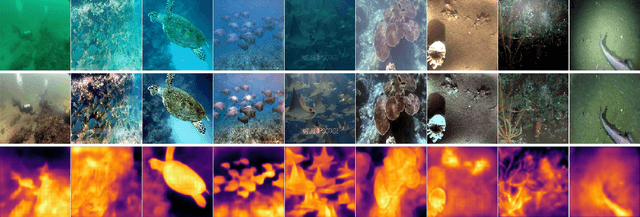
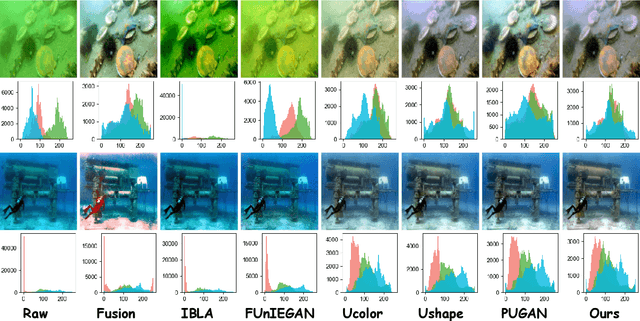
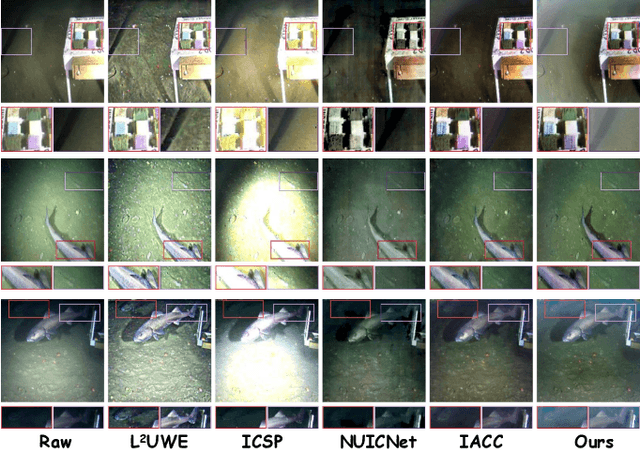
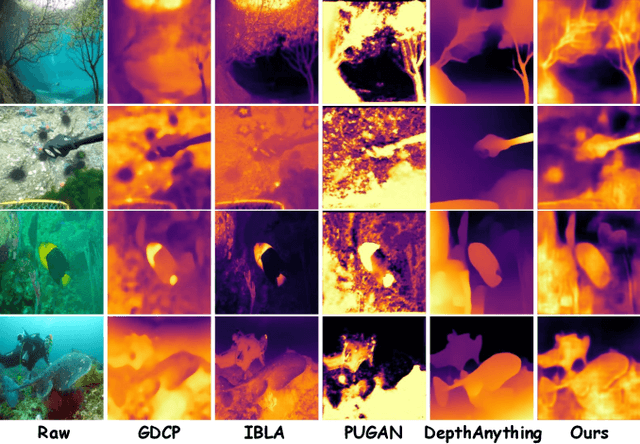
Abstract:Due to the selective absorption and scattering of light by diverse aquatic media, underwater images usually suffer from various visual degradations. Existing underwater image enhancement (UIE) approaches that combine underwater physical imaging models with neural networks often fail to accurately estimate imaging model parameters such as depth and veiling light, resulting in poor performance in certain scenarios. To address this issue, we propose a physical model-guided framework for jointly training a Deep Degradation Model (DDM) with any advanced UIE model. DDM includes three well-designed sub-networks to accurately estimate various imaging parameters: a veiling light estimation sub-network, a factors estimation sub-network, and a depth estimation sub-network. Based on the estimated parameters and the underwater physical imaging model, we impose physical constraints on the enhancement process by modeling the relationship between underwater images and desired clean images, i.e., outputs of the UIE model. Moreover, while our framework is compatible with any UIE model, we design a simple yet effective fully convolutional UIE model, termed UIEConv. UIEConv utilizes both global and local features for image enhancement through a dual-branch structure. UIEConv trained within our framework achieves remarkable enhancement results across diverse underwater scenes. Furthermore, as a byproduct of UIE, the trained depth estimation sub-network enables accurate underwater scene depth estimation. Extensive experiments conducted in various real underwater imaging scenarios, including deep-sea environments with artificial light sources, validate the effectiveness of our framework and the UIEConv model.
End-To-End Underwater Video Enhancement: Dataset and Model
Mar 18, 2024Abstract:Underwater video enhancement (UVE) aims to improve the visibility and frame quality of underwater videos, which has significant implications for marine research and exploration. However, existing methods primarily focus on developing image enhancement algorithms to enhance each frame independently. There is a lack of supervised datasets and models specifically tailored for UVE tasks. To fill this gap, we construct the Synthetic Underwater Video Enhancement (SUVE) dataset, comprising 840 diverse underwater-style videos paired with ground-truth reference videos. Based on this dataset, we train a novel underwater video enhancement model, UVENet, which utilizes inter-frame relationships to achieve better enhancement performance. Through extensive experiments on both synthetic and real underwater videos, we demonstrate the effectiveness of our approach. This study represents the first comprehensive exploration of UVE to our knowledge. The code is available at https://anonymous.4open.science/r/UVENet.
UIEDP:Underwater Image Enhancement with Diffusion Prior
Dec 11, 2023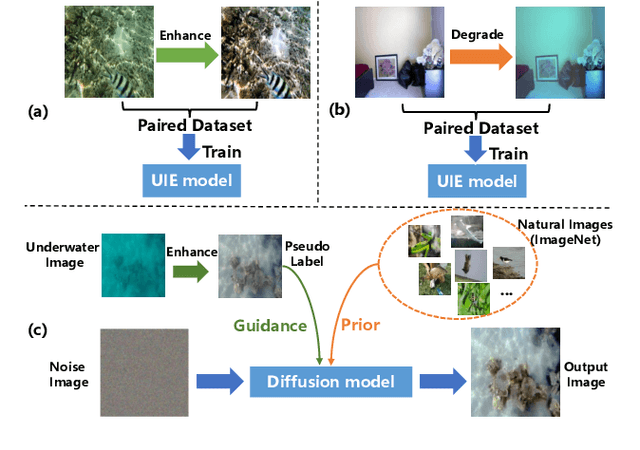

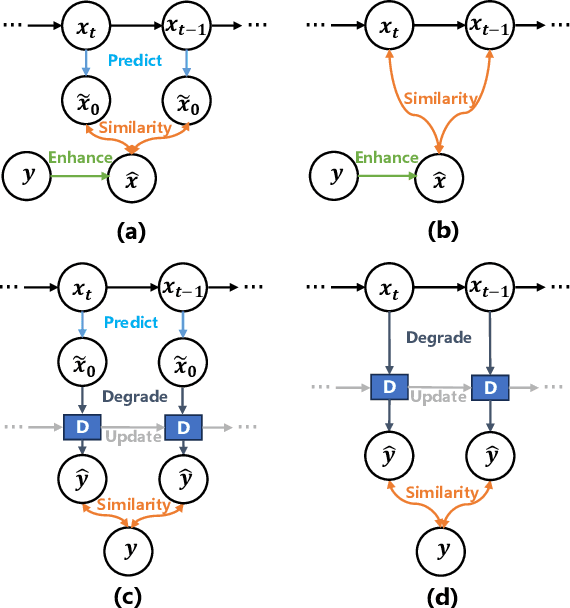

Abstract:Underwater image enhancement (UIE) aims to generate clear images from low-quality underwater images. Due to the unavailability of clear reference images, researchers often synthesize them to construct paired datasets for training deep models. However, these synthesized images may sometimes lack quality, adversely affecting training outcomes. To address this issue, we propose UIE with Diffusion Prior (UIEDP), a novel framework treating UIE as a posterior distribution sampling process of clear images conditioned on degraded underwater inputs. Specifically, UIEDP combines a pre-trained diffusion model capturing natural image priors with any existing UIE algorithm, leveraging the latter to guide conditional generation. The diffusion prior mitigates the drawbacks of inferior synthetic images, resulting in higher-quality image generation. Extensive experiments have demonstrated that our UIEDP yields significant improvements across various metrics, especially no-reference image quality assessment. And the generated enhanced images also exhibit a more natural appearance.
Timestamp-Supervised Action Segmentation in the Perspective of Clustering
Dec 22, 2022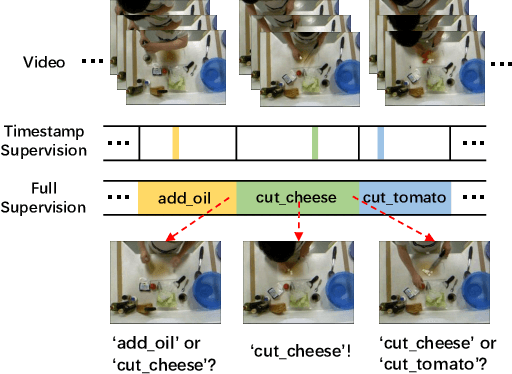
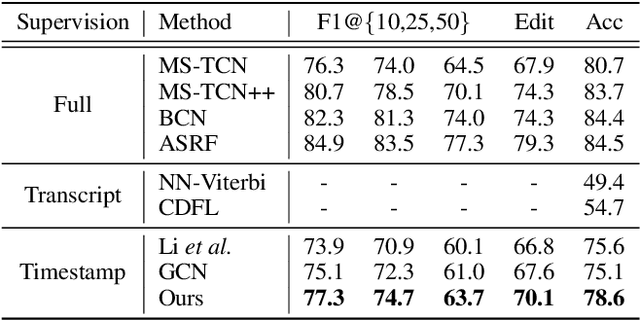
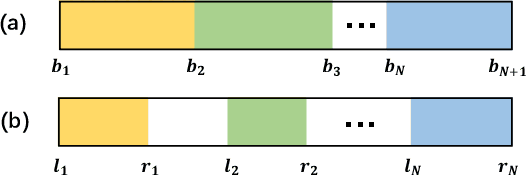
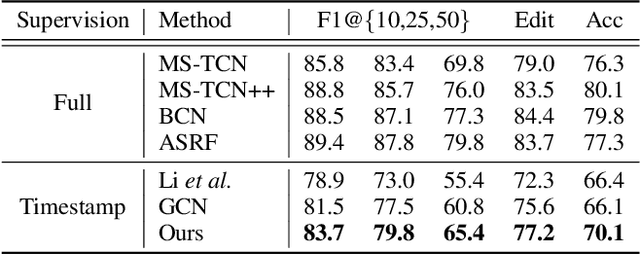
Abstract:Video action segmentation aims to slice the video into several action segments. Recently, timestamp supervision has received much attention due to lower annotation costs. We find the frames near the boundaries of action segments are in the transition region between two consecutive actions and have unclear semantics, which we call ambiguous intervals. Most existing methods iteratively generate pseudo-labels for all frames in each video to train the segmentation model. However, ambiguous intervals are more likely to be assigned with noisy and incorrect pseudo-labels, which leads to performance degradation. We propose a novel framework to train the model under timestamp supervision including the following two parts. First, pseudo-label ensembling generates pseudo-label sequences with ambiguous intervals, where the frames have no pseudo-labels. Second, iterative clustering iteratively propagates the pseudo-labels to the ambiguous intervals by clustering, and thus updates the pseudo-label sequences to train the model. We further introduce a clustering loss, which encourages the features of frames within the same action segment more compact. Extensive experiments show the effectiveness of our method.
A Molecular Multimodal Foundation Model Associating Molecule Graphs with Natural Language
Sep 12, 2022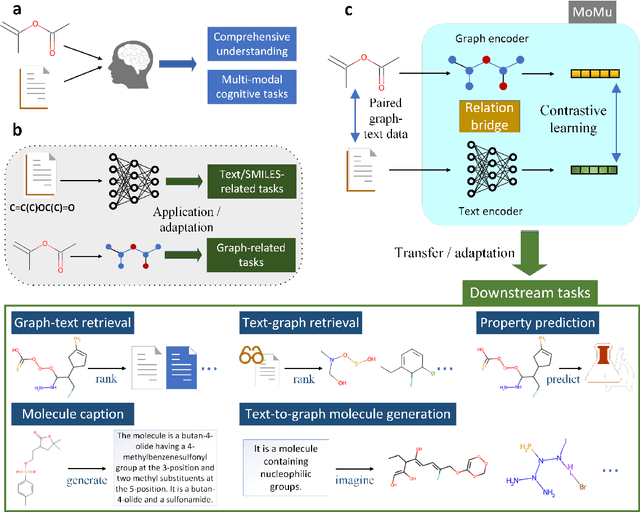
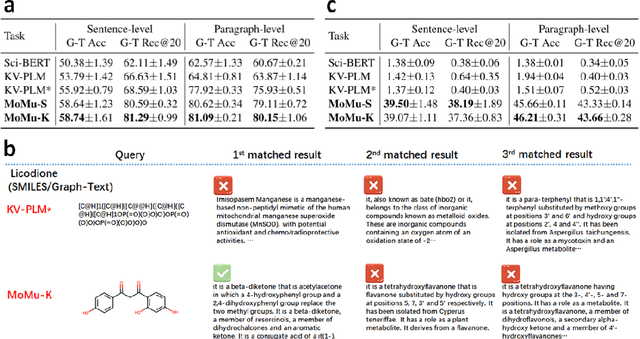
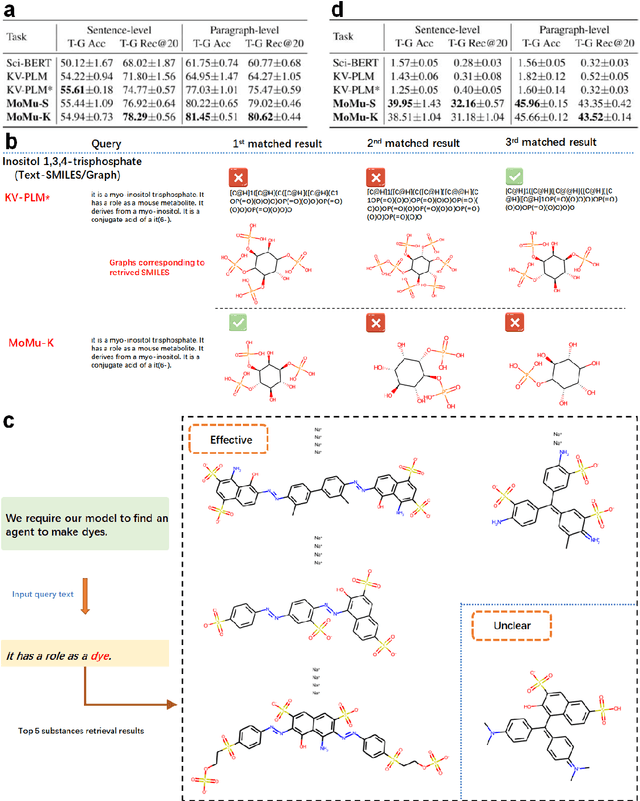
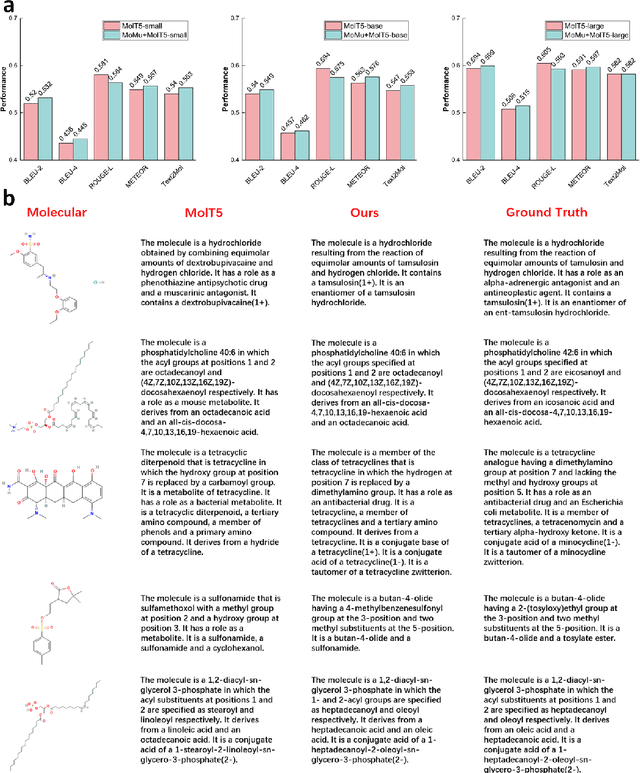
Abstract:Although artificial intelligence (AI) has made significant progress in understanding molecules in a wide range of fields, existing models generally acquire the single cognitive ability from the single molecular modality. Since the hierarchy of molecular knowledge is profound, even humans learn from different modalities including both intuitive diagrams and professional texts to assist their understanding. Inspired by this, we propose a molecular multimodal foundation model which is pretrained from molecular graphs and their semantically related textual data (crawled from published Scientific Citation Index papers) via contrastive learning. This AI model represents a critical attempt that directly bridges molecular graphs and natural language. Importantly, through capturing the specific and complementary information of the two modalities, our proposed model can better grasp molecular expertise. Experimental results show that our model not only exhibits promising performance in cross-modal tasks such as cross-modal retrieval and molecule caption, but also enhances molecular property prediction and possesses capability to generate meaningful molecular graphs from natural language descriptions. We believe that our model would have a broad impact on AI-empowered fields across disciplines such as biology, chemistry, materials, environment, and medicine, among others.
Efficient U-Transformer with Boundary-Aware Loss for Action Segmentation
May 26, 2022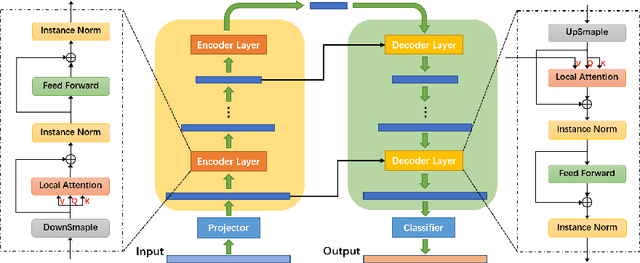
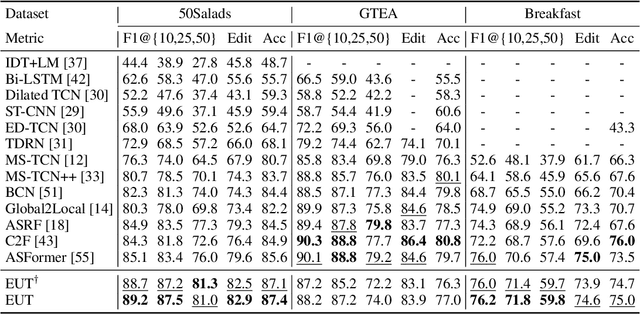

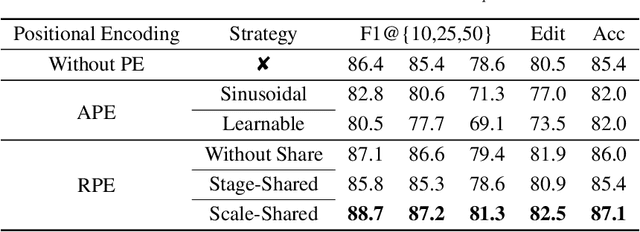
Abstract:Action classification has made great progress, but segmenting and recognizing actions from long untrimmed videos remains a challenging problem. Most state-of-the-art methods focus on designing temporal convolution-based models, but the limitations on modeling long-term temporal dependencies and inflexibility of temporal convolutions limit the potential of these models. Recently, Transformer-based models with flexible and strong sequence modeling ability have been applied in various tasks. However, the lack of inductive bias and the inefficiency of handling long video sequences limit the application of Transformer in action segmentation. In this paper, we design a pure Transformer-based model without temporal convolutions by incorporating the U-Net architecture. The U-Transformer architecture reduces complexity while introducing an inductive bias that adjacent frames are more likely to belong to the same class, but the introduction of coarse resolutions results in the misclassification of boundaries. We observe that the similarity distribution between a boundary frame and its neighboring frames depends on whether the boundary frame is the start or end of an action segment. Therefore, we further propose a boundary-aware loss based on the distribution of similarity scores between frames from attention modules to enhance the ability to recognize boundaries. Extensive experiments show the effectiveness of our model.
Preformer: Predictive Transformer with Multi-Scale Segment-wise Correlations for Long-Term Time Series Forecasting
Feb 23, 2022
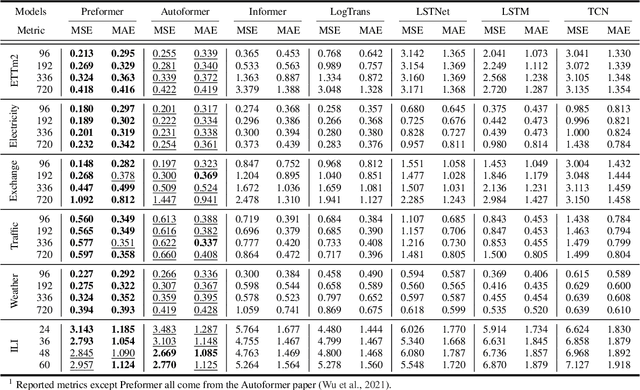
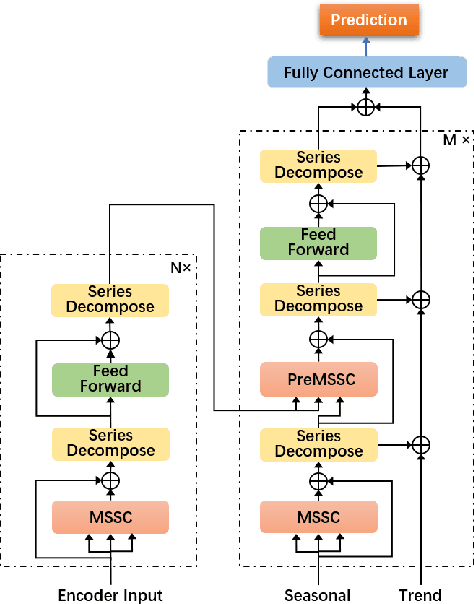

Abstract:Transformer-based methods have shown great potential in long-term time series forecasting. However, most of these methods adopt the standard point-wise self-attention mechanism, which not only becomes intractable for long-term forecasting since its complexity increases quadratically with the length of time series, but also cannot explicitly capture the predictive dependencies from contexts since the corresponding key and value are transformed from the same point. This paper proposes a predictive Transformer-based model called {\em Preformer}. Preformer introduces a novel efficient {\em Multi-Scale Segment-Correlation} mechanism that divides time series into segments and utilizes segment-wise correlation-based attention for encoding time series. A multi-scale structure is developed to aggregate dependencies at different temporal scales and facilitate the selection of segment length. Preformer further designs a predictive paradigm for decoding, where the key and value come from two successive segments rather than the same segment. In this way, if a key segment has a high correlation score with the query segment, its successive segment contributes more to the prediction of the query segment. Extensive experiments demonstrate that our Preformer outperforms other Transformer-based methods.
 Add to Chrome
Add to Chrome Add to Firefox
Add to Firefox Add to Edge
Add to Edge